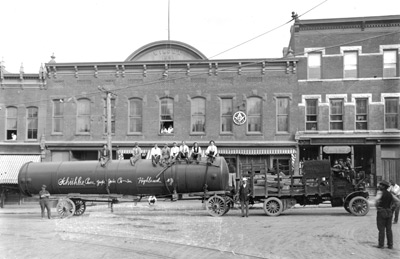
Postcard for Schuhle's Pure Highland Grape Juice Company, circa 1915, on Vineyard Ave, Highland. Also see postcard below of the Schuhle family.
Ulster Bounty
Fall 2011
The first thing newcomers notice about Ulster County is how green it is—how trees fill every vista. It is said there are more trees here now than 100 years ago.
With a land and water area of 1,161 square miles, Ulster boasts some of the largest tracks of woodlands and forested areas in New York. Ulster’s “wild” areas include parts of the Catskill Park, Minnewaska State Park Preserve, Mohonk Preserve, Sundown State Park, VerNooykill State Forest, Witches Hole State Forest, Shawangunk Ridge State Forest, and Sam’s Point Preserve (which includes rare dwarf pines).

Ten year old Dorothy Whitman and friend, Shantang’s Bungalow Colony, Saugerties, 1924. She married Louis Yess in 1940 and they lived the rest of their lives on the land of his family’s Lloyd and Esopus farm.
In addition to those large park areas we have dozens of smaller parks and preserves including Frannie Reese Park in Highland, the Shaupeneak and the Black Creek Preserves in Esopus, the Esopus Bend Nature Preserve in Saugerties, the Harcourt Sanctuary in New Paltz, to name just a few. Adding to the county’s verdant growth, about 3% of the area is under water.
The topography of Ulster runs from sea level along the Hudson River to about 4,180 feet on Slide Mountain providing a variety of landscapes and many opportunities to grow crops or raise animals. Slide Mountain, for instance, has the most rainfall of any spot in northeast America. That consistent rainfall provides the headwaters for two major trout streams and supplies water to some of NY City’s major reservoirs.
There was a time in living memory when much of Ulster’s land was tamed—treeless, chopped and “cropped.” Between the appetite for hemlock of the tanning industry, the building industry’s quest for hardwoods for ships, homes, and factories, the steam mills’ and steam locomotives’ need for fire wood, and the agricultural necessity of baskets and barrels for shipping produce, it is amazing there were any trees left. A look at photographs or postcards from the early 1900s shows the landscape was orchards, vineyards, berry patches, dairy forage, open fields, or woodlots. Standing trees were most cherished for cooling residential streets, often lining them with huge American linden, silver maple, or American chestnut. How many towns contain streets commemorating the trees that once graced them?
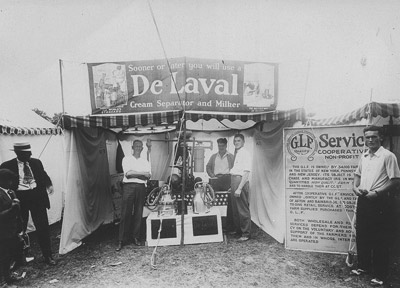
DeLaval Company made cream separators and milking machines in Dutchess County that were used around the world and by local dairys.
Marginal lands that seemed too steep or too boggy, were improved or used to grow specialized crops. East facing hillsides were sought for vineyards. (Joe Indelicato of Highland has a plow especially designed just for hill tilling). Swamps were drained. One of the larger draining projects ran between N. Eltings Corners Road and Plutarch Road. The project, known as Crozier’s Ditch created a streambed to drain the water from the rich black dirt. Farmers along the length of the ditch saw their tillable acreage expand. Over time the ditch has filled in, the beaver have raised the water level, and the “gains” are long gone, but the farmers are, too.
Joan Burroughs, great-granddaughter of naturalist John Burroughs, reminded me that the rocky, boggy land next to her grandfather’s historic cabin, Slabsides, in Esopus, was where he grew celery for the New York City market. It was one of the first commercial celery plots in New York State. At John Burroughs’ main farm, “Riverby,” on the Hudson River in West Park, he grew grapes and experimented with many food crops.
Burroughs’ West Park contemporary, the 1904 US Presidential Candidate, Judge Alton B. Parker, was a trusted advisor on farming to many neighbors according to Mary Polhemus’ article in The Town of Esopus Story.
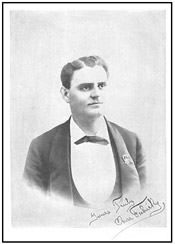 Another farm of the early 1900s producing food for the New York City market was Oscar Tshirky’s manicured lands between Route 32 North and the Wallkill River in New Paltz. Swiss-born Tshirky (1868-1950) was the world-renown Maitre ‘d hotel at the Waldorf Astoria from its opening in New York City in 1893 to his retirement in 1943.
Another farm of the early 1900s producing food for the New York City market was Oscar Tshirky’s manicured lands between Route 32 North and the Wallkill River in New Paltz. Swiss-born Tshirky (1868-1950) was the world-renown Maitre ‘d hotel at the Waldorf Astoria from its opening in New York City in 1893 to his retirement in 1943.
Prior to gracing the Waldorf, Tshirky had influenced American taste with his work at the Hoffman House and Delmonico’s, both famous New York City restaurants. Tshirky is credited with creating Waldorf Salad (easy and delicious) and other signature dishes.
Oscar’s Waldorf Salad
“Peel two raw apples and cut them into small pieces, say about half an inch square, also cut some celery the same way, and mix it with the apple. Be very careful not to let any seeds of the apples be mixed with it. The salad must be dressed with a good mayonnaise.”
Walnuts were added to the recipe later (Oscar did not like Walnuts).
The postcard accompanying this article (below) shows the farm’s layout. Today, the main building and 40 acres of the land is a residence for 15 lucky people who enjoy Oscar’s charming home.
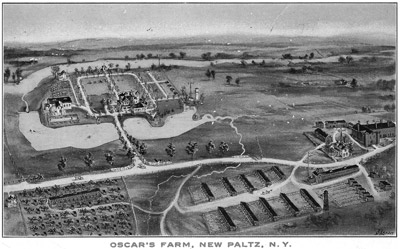
Oscar Tshirky’s farm, New Paltz, N.Y.
Tshirky left the property to a society of French chefs as a retirement home. Over time, the French chefs made other retirement plans and the last resident chefs of Tshirky’s home passed away. The facility was then open to other senior members of our community. You can learn more at their website at www.culinarianshome.com and see photos of the property today. It has retained much of its original charm, especially in the dining room, parlor and grounds.
In 1937, The Hudson Valley Fruit Exchange, Inc. published a booklet titled “Seven Objectives Ripen into Seven Millions in 25 Years” 1912-1937. (Thank you, Lindy Palladino for giving me this book!). It is the story of the first 25 years of the exchange and the men who shaped the organization. The names of the 53 Charter Members reads like an area telephone book of today and some names are on the 1915 photo of the Ulster County NYS Fair exhibit below.
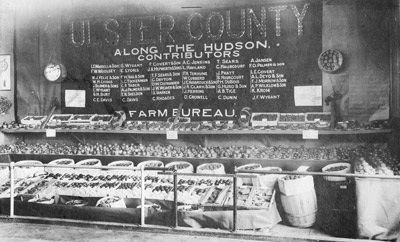
1915 Ulster County Agriculture display at NYS Fair, note names, some families still farm here.
The local farmers had wanted to form an organization to help “build up the industry.” The seven objectives were (loosely), education, legislation, transportation, uniform packaging, marketing, industry reporting, and cooperative purchasing of supplies.
The moving force was William Y. Velie, president from 1912-1919. The financial force was Major L.C. Tuckerman who generously supported the infant organization in its first few years.
The gross business of the Exchange in 1912 just was over $40,000. By 1937 it was well over $285,000.
The 1937 membership had grown to more than 350 farmers. Their lands were primarily in Ulster and Orange Counties. Their product was branded in 1923 as “Hudsonia” and for the buying public came to mean “a fancy grade and to the growers it means a premium price.” Paragraph headings in the book include: Peaches, Grapes, Apples, Cherries, Strawberries, and Red Currents.
“These people raised lots of things and had abundance; and lived well on what they raised”
C.M. Woolsey, History Of Marlborough
That sentence is in the Exchange book, as is a note at the end: “Type used is known in the printing trade as ‘Goudy Handtooled’ and Goudy bold Italic. These faces were designed by Frederick W. Goudy of Marlborough, one of the foremost type designers of all time.” Goudy is used in Woolsey’s quote above.
The land along the Wallkill River west of New Paltz is known as “the flats.” The river floods almost every spring (and sometimes in winter from ice dams) bringing soil from the south as the river flows north eventually meeting up with the Rondout and going on together to the Hudson. This refreshing of the soil has kept the land productive for centuries, and today is augmented with chemical fertilizers.

Among the first to market fertilizers locally was James Pine, shown in the photo above holding an empty bag amid a flourishing crop of… not sure, maybe potato. Another photo, below, provides a similar scene in a New Paltz onion field. Both photos are by H.L. Shultz, around 1910.
The fertalizer bags say “The Standard Fertilizers Work Freely in Any Drill. Manufactured Only by Standard Fertilizer, Boston, Mass. Works. Duxbury, Mass. Bristol, ME. For Sale By James C. Pine New Paltz.”
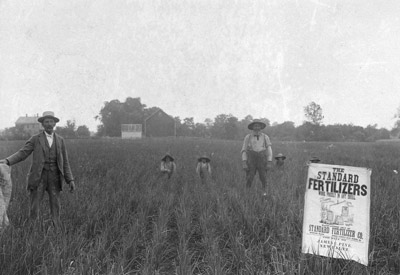
One crop that did very well locally, at least until Prohibition, was wine grapes. Almost every farm had its own vineyard. Exotic cuttings were swapped back and forth, grafted onto the blight resistant American root stock.
One of the larger early (1888) wineries was Hudson Valley Winery owned by the Bolognesi Brothers. According to Times and Tales of the Town of Lloyd, the family had over 400 years of wine making experience in Italy which they combined successfully with “modern technology” and “produced wines of high distinction in the field of American vintages. Over a dozen wine varieties and champagne were produced from native grapes and perfected through years of cultivation.”
Today, Ulster County has several wineries, and the reputation of local wines has earned kudos and awards. (See the calendar for a wine tasting tour for the holidays).
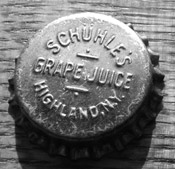 The John Schuhle family (see also photo at top) began their grape juice plant in Highland in 1907, eventually shipping all over the country and even to the Philippine Islands.
The John Schuhle family (see also photo at top) began their grape juice plant in Highland in 1907, eventually shipping all over the country and even to the Philippine Islands.
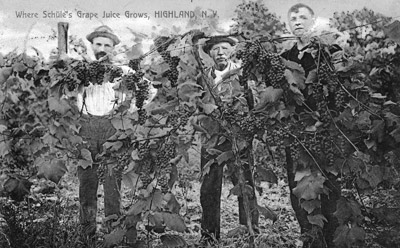
Where Schuhle’s Grape Juice Grows, Highland, N.Y.
In 1920 the factory was sold to the Rexall Company. Rexall made Marischino cherries there. The cherries were white from a preservative and then were dyed bright red at the plant. Rexall also made chocolate syrup and other soda fountain toppings. The factory changed hands again in 1955, purchased by Seneca Grape Juice Company and was used to bottle other juices. The factory building has changed hands several times and now is used for storage.
Ulster’s bounty was not limited to crops that grew from its soil. Bluestone, clay (for brickmaking) and cement were valuable commodities and the foundations for many a local fortune.
But it was the small farming family who fires the imagination of Ulster’s gifts: From E. Poll and K.K. Elia’s Images of America Series, Saugerties…
“The Wolvens did subsistence farming, raising a variety of animals and crops for their own use. Horses did the heavy work. Even the dog ran a treadmill attached to a butter churn. The Wolvens fashioned linen clothes from flax they grew on their farm.”
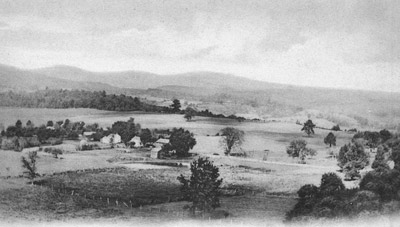
Looking North from The Church Tower in Stone Ridge circa 1900.
By Vivian Yess Wadlin. Images are from her collection & the Town of Lloyd Historian’s Office.

Part of the J.W. Dimick (also Dimmick) Farm, Dashville-Rifton, around 1900. Dimmick was best known for his huge mill on the Wallkill that made yarns, rugs, and cloth. Like so many entrepreneurs of the day, he had his own farm and dairy. This photo is of his prized registered Holstein cattle. Dimick built two toll bridges known as the “Twin Bridges,” one from what is now Route 213 to an island, continuing on a short road across the island, and then a second bridge over to Rosendale. Later he turned them over to the town. Prior to those bridges, one had to use Perrine’s covered bridge. It is probably the oldest in NYS and most likely the last burr arch bridge. Much of the Dimick estate is today owned by the Bruderhof. Like Dimmick, they have a variety of businesses to support their organization. Not all their eggs are in one basket and Dimmick would have approved. Dimick’s mills supplied blankets to the Grand Army of the Republic (Union Army) in the 1860s. The first years of 1900 were prosperous for all of the businesses and workers in Dashville and Rifton. Dimick sold land to and built homes on easy terms for the workers in his industries.
The heyday of the little Old and New Rifton communitys ended with labor strife, Dimick’s death, and a sour economy.The JW Dimick Carpet mill closed in 1915. Today, ruins of some of the buildings still dot the Wallkill shore, but the most complete reminder of Dimick and his day is the small building below the road at the intersection of 213 and Cowhough Rds. It was the pump house to supply water to the Dimick’s home on top of the hill. The home is not visible, but the well house is.
